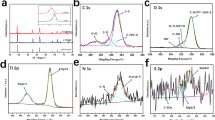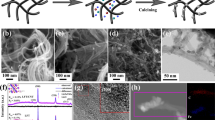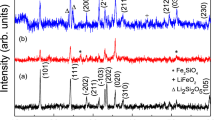Abstract
A series of nitrogen-doped carbon coating Li2FeSiO4-C (LFS-NCs) nanocrystalline was manufactured by using dicyandiamide as the nitrogen source. The introduction of nitrogen did not cause structural changes. However, it slightly decreases the average particle size and increases the lithium ion diffusion coefficients which benefit its electrochemical performance, especially at low discharge current density. Also, the enhanced electronic conductivity took positive effect in improving the electrochemical performance, especially at relative higher current density. Sample with nitrogen content of 0.55 wt.% shows the best electrochemical performance, with high capacity of 293.4 mAh g−1 at 0.1 C, corresponding to 1.77 reversible Li+ extraction/insertion per molecular. At 0.2 C after 50 cycles, the capacity stabled at 172.7 mAh g−1, showing excellent cyclic performance.










Similar content being viewed by others
References
Nytén A, Abouimrane A, Armand M, Gustafsson T, Thomas JO (2005) Electrochemical performance of Li2FeSiO4 as a new Li-battery cathode material. Electrochem Commun 7(2):156–160
Ni J, Jiang Y, Bi X, Li L, Lu J (2017) Lithium iron orthosilicate cathode: progress and perspectives. ACS Energy Lett 2(8):1771–1781
Lv D, Bai J, Zhang P, Wu S, Li Y, Wen W, Jiang Z, Mi J, Zhu Z, Yang Y (2013) Understanding the high capacity of Li2FeSiO4: in situ XRD/XANES study combined with first-principles calculations. Chem Mater 25(10):2014–2020
Sivaraj P, Abhilash KP, Nalini B, Selvin PC, Goel S, Yadav SK (2019) Insight into cations substitution on structural and electrochemical properties of nanostructured Li2FeSiO4/C cathodes. J Am Ceram Soc 103(3):1685–1697
Armstrong AR, Kuganathan N, Islam MS, Bruce PG (2011) Structure and lithium transport pathways in Li2FeSiO4 cathodes for lithium batteries. J Am Chem Soc 133(33):13031–13035
Nytén A, Kamali S, Häggström L, Gustafsson T, Thomas JO (2006) The lithium extraction/insertion mechanism in Li2FeSiO4. J Mater Chem 16(23):2266–2272
Qiu H, Jin D, Wang C, Chen G, Wang L, Yue H, Zhang D (2020) Design of Li2FeSiO4 cathode material for enhanced lithium-ion storage performance. Chem Eng J 379:122329
Peng P, Guo W, Zhang Y, Wang Y, Zhu K, Guo Y, Wang Y, Lu Y, Yan H (2019) The core-shell heterostructure CNT@Li2FeSiO4@C as a highly stable cathode material for lithium-ion batteries. Nanoscale Res Lett 14(1):326
Ding Z, Zhang D, Feng Y, Zhang F, Chen L, Du Y, Ivey DG, Wei W (2018) Tuning anisotropic ion transport in mesocrystalline lithium orthosilicate nanostructures with preferentially exposed facets. NPG Asia Mater 10(7):606–617
Xu Y, Shen W, Zhang A, Liu H, Ma Z (2014) Template-free hydrothermal synthesis of Li2FeSiO4 hollow spheres as cathode materials for lithium-ion batteries. J Mater Chem A 2(32):12982
Shen S, Zhang Y, Wei G, Zhang W, Yan X, Xia G, Wu A, Ke C, Zhang J (2018) Li2FeSiO4/C hollow nanospheres as cathode materials for lithium-ion batteries. Nano Res 12(2):357–363
Hsu C-H, Du T-R, Tsao C-H, Lin H-P, Kuo P-L (2019) Hollow Li2FeSiO4 spheres as cathode and anode material for lithium-ion battery. J Alloys Compd 797:1007–1012
Zeng Y, Chiu H-C, Rasool M, Brodusch N, Gauvin R, Jiang D-T, Ryan DH, Zaghib K, Demopoulos GP (2019) Hydrothermal crystallization of Pmn21 Li2FeSiO4 hollow mesocrystals for Li-ion cathode application. Chem Eng J 359:1592–1602
Zhang W, Liang L, Ju Y, Liu Y, Hou L, Yuan C (2019) Efficient electrospinning fabrication and the underlying formation mechanism of one-dimensional monoclinic Li2FeSiO4 nanofibers. CrystEngComm 21(42):6340–6345
Rangappa D, Murukanahally KD, Tomai T, Unemoto A, Honma I (2012) Ultrathin nanosheets of Li2MSiO4 (M = Fe, Mn) as high-capacity Li-ion battery electrode. Nano Lett 12(3):1146–1151
Devaraju MK, Tomai T, Honma I (2013) Supercritical hydrothermal synthesis of rod like Li2FeSiO4 particles for cathode application in lithium ion batteries. Electrochim Acta 109:75–81
Yang J, Hu L, Zheng J, He D, Tian L, Mu S, Pan F (2015) Li2FeSiO4 nanorods bonded with graphene for high performance batteries. J Mater Chem A 3(18):9601–9608
Yang J, Kang X, He D, Zheng A, Pan M, Mu S (2015) Graphene activated 3D-hierarchical flower-like Li2FeSiO4 for high-performance lithium-ion batteries. J Mater Chem A 3(32):16567–16573
Yan H, Xue X, Fu Y, Wu X, Dong J (2020) Three-dimensional carbon nanotubes-encapsulated Li2FeSiO4 microspheres as advanced positive materials for lithium energy storage. Ceram Int 46(7):9729–9733
Rasool M, Chiu HC, Zank B, Zeng Y, Zhou J, Zaghib K, Perepichka DF, Demopoulos GP (2020) PEDOT encapsulated and mechanochemically engineered silicate nanocrystals for high energy density cathodes. Adv Mater Interfaces 7(13):2000226
Zheng Z, Wang Y, Zhang A, Zhang T, Cheng F, Tao Z, Chen J (2012) Porous Li2FeSiO4/C nanocomposite as the cathode material of lithium-ion batteries. J Power Sources 198:229–235
Zeng Y, Chiu H-C, Ouyang B, Song J, Zaghib K, Demopoulos GP (2019) Unveiling the mechanism of improved capacity retention in Pmn21 Li2FeSiO4 cathode by cobalt substitution. J Mater Chem A 7(44):25399–25414
Qiu H, Yue H, Wang X, Zhang T, Zhang M, Fang Z, Zhao X, Chen G, Wei Y, Wang C, Zhang D (2017) Titanium-doped Li2FeSiO4/C composite as the cathode material for lithium-ion batteries with excellent rate capability and long cycle life. J Alloys Compd 725:860–868
Kumar A, Jayakumar OD, Jagannath J, Bashiri P, Nazri GA, Naik VM, Naik R (2017) Mg doped Li2FeSiO4/C nanocomposites synthesized by the solvothermal method for lithium ion batteries. Dalton Trans 46(38):12908–12915
Wang K, Teng G, Yang J, Tan R, Duan Y, Zheng J, Pan F (2015) Sn(ii,iv) steric and electronic structure effects enable self-selective doping on Fe/Si-sites of Li2FeSiO4 nanocrystals for high performance lithium ion batteries. J Mater Chem A 3(48):24437–24445
Bai T, Zhou H, Zhou X, Liao Q, Chen S, Yang J (2017) N-doped carbon-encapsulated MnO@graphene nanosheet as high-performance anode material for lithium-ion batteries. J Mater Sci 52(19):11608–11619
Wang J, Liu G, Fan K, Zhao D, Liu B, Jiang J, Qian D, Yang C, Li J (2018) N-doped carbon coated anatase TiO2 nanoparticles as superior Na-ion battery anodes. J Colloid Interface Sci 517:134–143
Kim H, Lim H, Kim H-S, Kim KJ, Byun D, Choi W (2018) Polydopamine-derived N-doped carbon-wrapped Na3V2(PO4)3 cathode with superior rate capability and cycling stability for sodium-ion batteries. Nano Res 12(2):397–404
Cao Y, Mao S, Li M, Chen Y, Wang Y (2017) Metal/porous carbon composites for heterogeneous catalysis: old catalysts with improved performance promoted by N-doping. ACS Catal 7(12):8090–8112
Yang M, Zhou Z (2017) Recent breakthroughs in supercapacitors boosted by nitrogen-rich porous carbon materials. Adv Sci 4(8):1600408
Wu J, Pan Z, Zhang Y, Wang B, Peng H (2018) The recent progress of nitrogen-doped carbon nanomaterials for electrochemical batteries. J Mater Chem A 6(27):12932–12944
Xu X, Niu F, Wang C, Li Y, Zhao C, Yang J, Qian Y (2019) Li3VO4 nanoparticles in N-doped carbon with porous structure as an advanced anode material for lithium-ion batteries. Chem Eng J 370:606–613
Zhao Y, Wang F, Wang C, Wang S, Wang C, Zhao Z, Duan L, Liu Y, Wu Y, Li W, Zhao D (2019) Encapsulating highly crystallized mesoporous Fe3O4 in hollow N-doped carbon nanospheres for high-capacity long-life sodium-ion batteries. Nano Energy 56:426–433
Liu H, Zhang S, Chen Y, Zhang J, Guo P, Liu M, Lu X, Zhang J, Wang Z (2018) Rational design of TiO2@ nitrogen-doped carbon coaxial nanotubes as anode for advanced lithium ion batteries. Appl Surf Sci 458:1018–1025
Gao HY, Wu QQ, Guo M, Yang SQ, Zhao YN, Kwon Y-U (2019) Rationally fabricating nitrogen-doped carbon coated nanocrystalline Li2FeSiO4@N-C with excellent Li-ion battery performances. Electrochim Acta 318:720–729
Yuan C, Chen W, Yan L (2012) Amino-grafted graphene as a stable and metal-free solid basic catalyst. J Mater Chem 22(15):7456
Sheng ZH, Shao L, Chen JJ, Bao WJ, Wang FB, Xia XH (2011) Catalyst-free synthesis of nitrogen-doped graphene via thermal annealing graphite oxide with melamine and its excellent electrocatalysis. ACS Nano 5(6):4350–4358
Wang H, Zhang C, Liu Z, Wang L, Han P, Xu H, Zhang K, Dong S, Yao J, Cui G (2011) Nitrogen-doped graphene nanosheets with excellent lithium storage properties. J Mater Chem 21(14):5430
Chizari K, Vena A, Laurentius L, Sundararaj U (2014) The effect of temperature on the morphology and chemical surface properties of nitrogen-doped carbon nanotubes. Carbon 68:369–379
Shen W, Wang C, Xu Q, Liu H, Wang Y (2015) Nitrogen-doping-induced defects of a carbon coating layer facilitate Na-storage in electrode materials. Adv Energy Mater 5(1):1400982
Du X, Zhao H, Lu Y, Gao C, Xia Q, Zhang Z (2016) Electrochemical properties of nanostructured Li2FeSiO4/C synthesized by a simple co-precipitation method. Electrochim Acta 188:744–751
Yi L, Wang X, Wang G, Bai Y, Liu M, Wang X, Yu R (2016) Improved electrochemical performance of spherical Li2FeSiO4/C cathode materials via Mn doping for lithium-ion batteries. Electrochim Acta 222:1354–1364
Zhang Q, Yan C, Meng Y, Wang X (2018) Hierarchical mesoporous Li2FeSiO4/C sheaf-rods as a high-performance lithium-ion battery cathode. J Alloys Compd 767:195–203
Zhang Q, Yan C, Guo J, Wang X (2017) Mesoporous Li2FeSiO4/C nanocomposites with enhanced performance synthesized from fumed nano silica. Ionics 24(9):2555–2563
Liu L, Shi G, Lu Y, Lian T, Zhao J, An H, Ma L (2019) Hydrothermal growth kinetics and electrochemical properties of Li2FeSiO4 nanoparticles. J Alloys Compd 797:1232–1239
Yi L, Wang G, Bai Y, Liu M, Wang X, Liu M, Wang X (2017) The effects of morphology and size on performances of Li2FeSiO4/C cathode materials. J Alloys Compd 721:683–690
Thayumanasundaram S, Rangasamy VS, Seo JW, Locquet J-P (2017) A combined approach: polyol synthesis of nanocrystalline Li2FeSiO4, doping multi-walled carbon nanotubes, and ionic liquid electrolyte to enhance cathode performance in Li-ion batteries. Electrochim Acta 258:1044–1052
Funding
This work was supported by Natural Science Foundations of China (No. 21703152, 21801136), and the Natural Science Foundations of Tianjin (No. 19JCQNJC02000, No. 18JCTPJC61200, and No. 18JCYBJC89100), the Foundation of Key Laboratory of Advanced Energy Materials Chemistry (Ministry of Education) in Nankai University, and the Open Fund of Fujian Provincial Key Laboratory of Eco-Industrial Green Technology (No. WYKF2019-4).
Author information
Authors and Affiliations
Corresponding authors
Additional information
Publisher’s note
Springer Nature remains neutral with regard to jurisdictional claims in published maps and institutional affiliations.
Rights and permissions
About this article
Cite this article
Gao, H., Deng, X., Wu, Q. et al. Improved capacity and cycling stability of Li2FeSiO4 nanocrystalline induced by nitrogen-doped carbon coating. J Solid State Electrochem 25, 1679–1689 (2021). https://doi.org/10.1007/s10008-021-04940-y
Received:
Revised:
Accepted:
Published:
Issue Date:
DOI: https://doi.org/10.1007/s10008-021-04940-y




